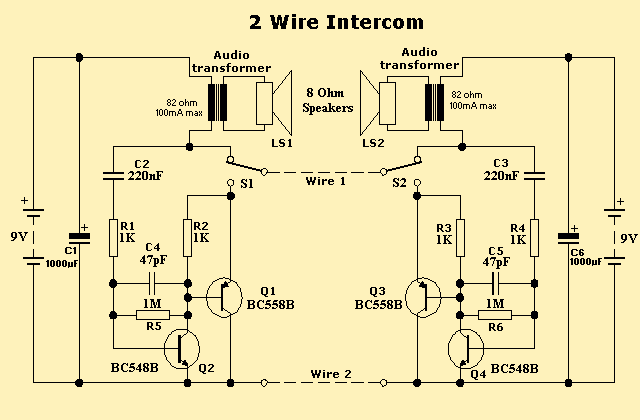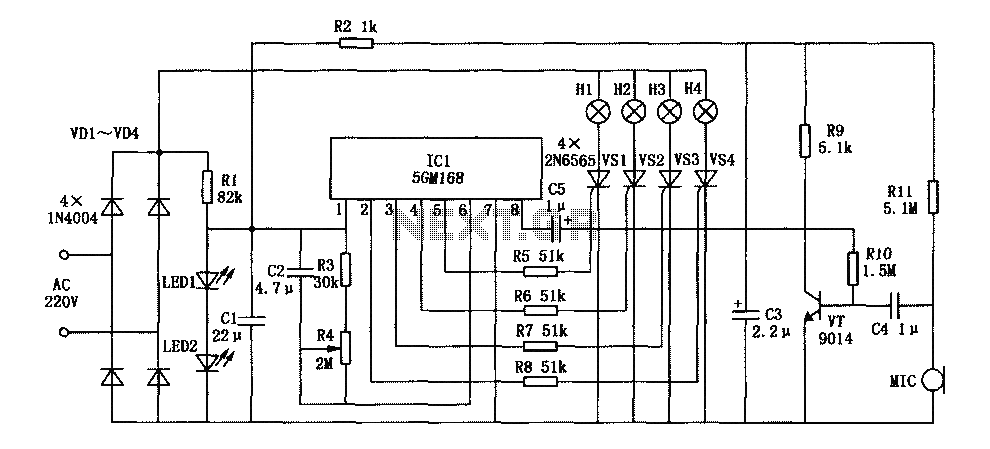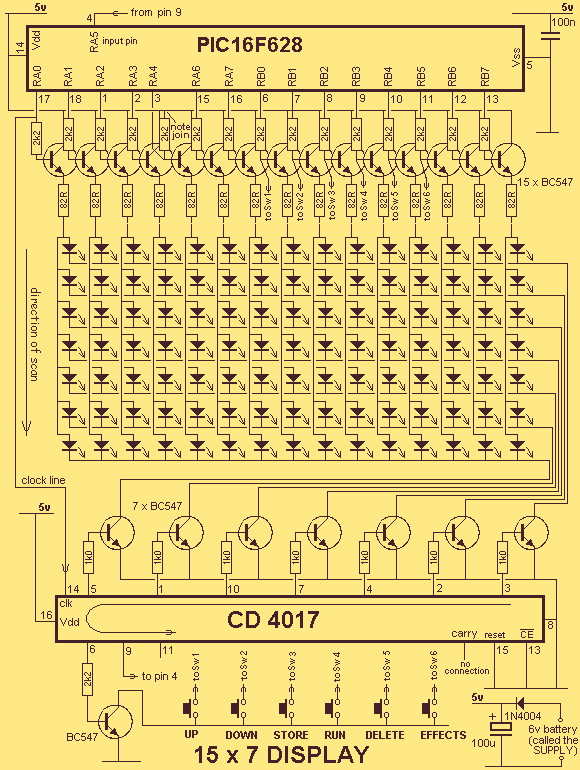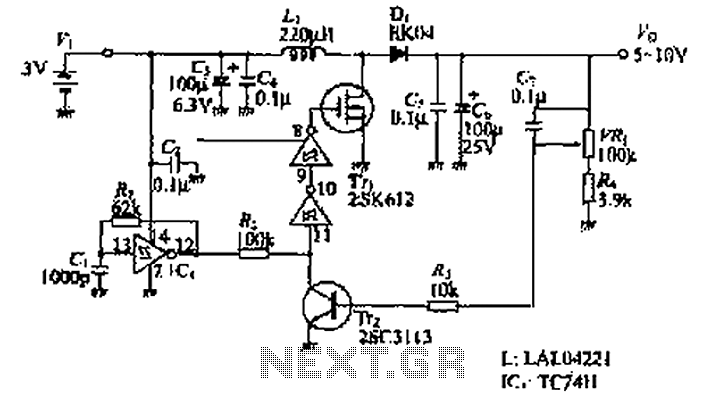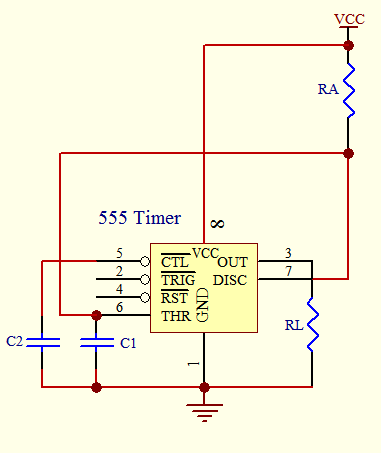
Super Led Flasher Circuit

The super LED flasher consists of two complete LED flasher circuits integrated onto a single circuit board. The first LED flasher is comprised of IC1 and LEDs D1 and D2. IC1 is a 555 timer IC configured as an astable multivibrator, with its output available at pin 3. The oscillation frequency of the 555 timer is determined by resistors R2, R3, and capacitor C1. Resistor R1 serves to limit the input voltage to a safe level, preventing potential damage to the IC. As the 555 timer oscillates, the output at pin 3 alternates between high (+) and low (-) states. When the output is high, current flows to LED D1, causing it to illuminate. Conversely, when the output is low, pin 3 sinks current, resulting in LED D2 lighting up. This behavior occurs because LEDs are polarity-sensitive devices, allowing current to flow in only one direction, and each LED is connected to the appropriate polarity required for illumination. The second LED flasher, consisting of IC2 and LEDs D3 and D4, operates in the same manner as the first LED flasher.
The super LED flasher circuit utilizes two 555 timer ICs, each configured as an astable multivibrator to create a flashing effect with two pairs of LEDs. The first section of the circuit, featuring IC1, is responsible for controlling the flashing of LEDs D1 and D2. The frequency of oscillation is determined by the values of resistors R2 and R3 along with capacitor C1. The timing components are selected based on the desired frequency of the LED flashing; for instance, a higher resistance value or capacitance will result in a slower flashing rate.
Resistor R1 is crucial for protecting the 555 timer from excessive voltage, ensuring that the IC operates within its specified limits. The output from pin 3 of IC1 is connected to the anode of LED D1, while the cathode is connected to ground. Similarly, LED D2 is connected to the output in a reverse manner, allowing it to light up when the output is low. The polarity-sensitive nature of the LEDs ensures that only one LED is illuminated at any given time, creating a visually appealing flashing effect.
The second LED flasher circuit, which consists of IC2, LEDs D3 and D4, mirrors the design of the first circuit. The same principles apply, with IC2 generating a complementary flashing effect for the second pair of LEDs. The design allows for simultaneous operation of both circuits, resulting in a coordinated flashing pattern. The integration of both circuits on a single board optimizes space and simplifies the overall design, making it suitable for various applications where visual alerts or indicators are necessary.
This dual LED flasher setup can be employed in decorative lighting, alarms, or any application requiring visual signaling. The flexibility of the 555 timer IC allows for easy adjustments to the flashing frequency, making it adaptable to different user requirements. The super LED flasher is actually two complete LED flasher circuits on one circuit board. The first, LED flasher is made up of 1C1 and LEDs D1 and D2. IC1 is a 555 timer IC configured as an astable (free-running) multivibrator with its output on pin 3. The frequency of the 555`s oscillation is controlled by R2, R3, and CI. Resistor R1 limits the input voltage to a low enough level to prevent damage to the IC. As the 555 IC oscillates, the output of pin 3 goes high (+) then low (-). When the output is high it supplies current to Dl, which lights up. When it is low, pin 3 sinks current and D2 lights up. This happens because LEDs are polarity-sensi-tive (like all other diodes, they permit current flow in only one direction) and one lead of each LED has been connected to the respective polarity needed to light that LED.
The second LED llasher, made up of IC2 and LEDs D3 and D4, operates in the same way as the first LED flasher. 🔗 External reference
The super LED flasher circuit utilizes two 555 timer ICs, each configured as an astable multivibrator to create a flashing effect with two pairs of LEDs. The first section of the circuit, featuring IC1, is responsible for controlling the flashing of LEDs D1 and D2. The frequency of oscillation is determined by the values of resistors R2 and R3 along with capacitor C1. The timing components are selected based on the desired frequency of the LED flashing; for instance, a higher resistance value or capacitance will result in a slower flashing rate.
Resistor R1 is crucial for protecting the 555 timer from excessive voltage, ensuring that the IC operates within its specified limits. The output from pin 3 of IC1 is connected to the anode of LED D1, while the cathode is connected to ground. Similarly, LED D2 is connected to the output in a reverse manner, allowing it to light up when the output is low. The polarity-sensitive nature of the LEDs ensures that only one LED is illuminated at any given time, creating a visually appealing flashing effect.
The second LED flasher circuit, which consists of IC2, LEDs D3 and D4, mirrors the design of the first circuit. The same principles apply, with IC2 generating a complementary flashing effect for the second pair of LEDs. The design allows for simultaneous operation of both circuits, resulting in a coordinated flashing pattern. The integration of both circuits on a single board optimizes space and simplifies the overall design, making it suitable for various applications where visual alerts or indicators are necessary.
This dual LED flasher setup can be employed in decorative lighting, alarms, or any application requiring visual signaling. The flexibility of the 555 timer IC allows for easy adjustments to the flashing frequency, making it adaptable to different user requirements. The super LED flasher is actually two complete LED flasher circuits on one circuit board. The first, LED flasher is made up of 1C1 and LEDs D1 and D2. IC1 is a 555 timer IC configured as an astable (free-running) multivibrator with its output on pin 3. The frequency of the 555`s oscillation is controlled by R2, R3, and CI. Resistor R1 limits the input voltage to a low enough level to prevent damage to the IC. As the 555 IC oscillates, the output of pin 3 goes high (+) then low (-). When the output is high it supplies current to Dl, which lights up. When it is low, pin 3 sinks current and D2 lights up. This happens because LEDs are polarity-sensi-tive (like all other diodes, they permit current flow in only one direction) and one lead of each LED has been connected to the respective polarity needed to light that LED.
The second LED llasher, made up of IC2 and LEDs D3 and D4, operates in the same way as the first LED flasher. 🔗 External reference
Warning: include(partials/cookie-banner.php): Failed to open stream: Permission denied in /var/www/html/nextgr/view-circuit.php on line 713
Warning: include(): Failed opening 'partials/cookie-banner.php' for inclusion (include_path='.:/usr/share/php') in /var/www/html/nextgr/view-circuit.php on line 713

